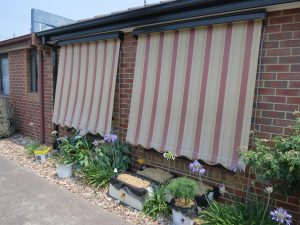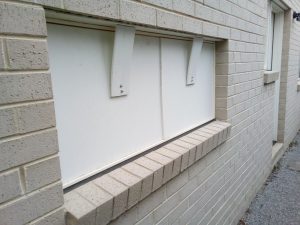We decided to put our low power/blackout resilient cooling system to the test yesterday. Despite a high of 45 degrees Celsius (113 Fahrenheit), we were able to stay comfortable using just 1% of the energy that we would have needed with air conditioning.
As a disclaimer, the temperatures below where not measured with calibrated instruments under scientific conditions, they are just a guide which we used alongside the reports from the Bureau of Meteorology for our region.
To give you an idea of what we are working with, our home is a late 1980s build and though it’s well built, it wouldn’t achieve better than a 2 star energy rating based on its age and features. It has east and west facing windows and no summer shading between 8am and 7pm.
In preparation for Friday’s hot weather, we charged up our back-up system battery from our back up solar system and pre-cooled the house by leaving a couple of windows open on the previous night.
We used the screen doors to let in cool air whilst watering the garden at 7am. At this time, the indoor temperature was 17 degrees.
When the outdoor temperature reached 17 degrees before 8am, we closed everything up to keep the indoors cool for as long as possible.
We also shut the exterior and interior blinds to keep the sun out as most of the heat that gets indoors in summer comes through the windows. At this point, we were both a little cold which is a good start for a hot day.

Throughout the morning, the temperature slowly climbed and by 3pm, the indoor temperature was 26 degrees while the outdoor temperature was 44 degrees.
At this point, we needed some personal cooling to maintain thermal comfort so we switched on our personal evaporative cooler. It has multiple vents, so when placed on an object like a coffee table, it can easily cool several people sitting on a couch which is how we used it.
By 6pm, the maximum outdoor temperature of 45 degrees had been reached and the maximum indoor temperature hit 29 degrees and stayed there until 11pm when it slowly began to decline.
The personal evaporative cooler kept us nice and cool under these conditions and continued to do so while we slept (following a refreshing cold shower). A fan would also have worked fine under these conditions.
In the early hours of Saturday morning, a cool change came through. The interior temperature was still 26 degrees at 6am though it quickly fell to 23 degrees after some windows were opened. The evaporative cooler consumed a measly 6 Watts, or a total of 0.09kWh for the whole day and 4 litres of water.
A personal fan would have used 0.5kWh (5 times as much) and our air conditioner would have used 13.5kWh (roughly 30 times as much as the fan and 150 times as much as the evaporative cooler).

Here’s what we can share from our experience:
- If you’ve got a reasonably cool night or morning beforehand, open some windows to pre-cool your home as it helps to keep it cooler for longer.
- Postpone strenuous tasks if possible or do them in the cool of the morning or evening.
- Keep cooking to minimum as it makes no sense to produce unnecessary heat in the kitchen or even make up some meals the day before that taste delicious cold.
- Cool water from the fridge can be refreshing.
- If you find yourself getting a bit warm from an unavoidable task in the heat, a cold or cool shower is a great way to cool down and freshen up (as is a swim if you live near water).
- We have found personal cooling like fans and personal evaporative coolers to be effective in indoor temperatures of up to 30-32 degrees (the cooling limit of any fan based cooling is 35 degrees [1]).
- The other advantage of personal cooling is that it can be adjusted to suit the temperature requirements of each individual rather than a pre-determined temperature that suits only one person the most.
- You can use air conditioning for indoor temperatures above 30 degrees to bring your most important one or two rooms back to 26 degrees and combine it with personal cooling to slash your air conditioning needs.
- Keep an eye on the weather report to see when a cool change is coming and when it does, you can switch off your cooling and throw open the windows to cool the house down.
- Keep an eye out for neighbours, especially neighbours vulnerable to heat stress as you can help them out in the case of a blackout, or if the indoor temperature of their home becomes unsafe.
- Learning to keep your house cool with little to no grid energy means that you are insulated against blackouts.
- You are also a benefit to others by helping to reduce stress when the grid experiences peak demand in hot weather and can even assist vulnerable neighbours.

Of course, no system is perfect. The one change we would make is to use a fan for sleeping instead of the portable evaporative cooler (as the noise of a fan is more pleasant to sleep to) and just use the portable evaporative cooler to sleep to if there is a blackout.
There’s also the option of using a 12 volt DC fan to keep the whole thing running on our solar system.
Our biggest challenge will be on a hot day that follows a hot night where pre-cooling is harder to achieve.
We made this work in Germany where we experienced a 2 month heatwave without air conditioning where every day had a maximum temperature of 30-40 degrees and the nights were warm.
The next time this happens, we’ll let you know how it goes. Until then, stay cool and enjoy the festive season.
Post script 29/03/20: We continued to use this system all the way through summer and it worked really well; our air conditioner wasn’t needed at all and we had a 2 hour blackout on a hot day where our cooling system continued to work.
Posts HomePage
Further Reading:
[1] If you want to learn something interesting, here’s an in depth article on how fans work for personal cooling and why they are better bang for your cooling buck than air conditioning:
https://www.lowtechmagazine.com/2014/09/circulating-fans-air-conditioning.html